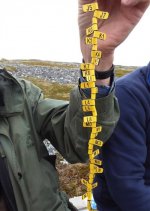Mark B Bartosik
Well-known member
I have no idea why banding organizations choose flags to use on knots (or did not stop using them) which have engrave painted numbers and letters that are becoming very hard or even impossible to read on some flags in the environment knots are living.
Here one can see a few examples:
http://www.pbase.com/mbb/image/166727431
Lime green flags with black lettering are loosing black paint over the time and becoming very hard to read; impossible to read from far away or in poor or harsh light.
Dark green flags with white littering accumulating some black stuff that is becoming gray and later black; this can be confusing when reporting colors but matter became much worse when this black stuff start to overflow engraved grooves and makes letters and numbers hard or even impossible to read. Can anybody guess numbers in last two dark green flags? I was lucky to get those from the other side of the flag.
I use better than average photo equipment and have a few years experience with collecting a lot of banding data in the field but very often I need to spend much more time to get verifiable documentation of the flagged REKN than, for example, when photographing relatively tiny alphanumeric bands or flags on species like PIPL or LETE. I have seen wrongly reported bands on REKN and I cannot really blame people for making those mistake. On the other hand, one should not report the band if one is not 100% sure without making note about it and for sure databases should not accept those data.
To my understanding one of main reason alphanumeric flags or bands are put on birds is to increase the resight numbers by birders with binoculars or scopes, often no photo documentation is done or low end equipment is used to obtain the photo. As it can be seen in presented photo collage sometimes it would be easy to make the mistake and in the worse scenario impossible to read the flag no matter how good equipment one is using. I would assume that this problem is know for some time so I do not understand why those flags are not replaced by a new, improved design.
In presented photos there are two marked as new flags. I believe photos were taken in ten days or less after those flags were put on birds as those knots numbered 224-274 just ‘popped up’ on the Padre Island but I could not find any info on the internet about banding action on that island recently. Looks like at least 50 knots were flagged in second part of October - I took photos of 25 of them. BTW I had great opportunity to look at flagged REKN on the Texas shore when I found and documented 120 flagged knots in October. I posted some info here http://www.birdforum.net/showthread.php?p=3655710#post3655710 if anybody is interested to read about it. Perhaps a few people can answer a few questions I posted there or share their opinions.
Here one can see a few examples:
http://www.pbase.com/mbb/image/166727431
Lime green flags with black lettering are loosing black paint over the time and becoming very hard to read; impossible to read from far away or in poor or harsh light.
Dark green flags with white littering accumulating some black stuff that is becoming gray and later black; this can be confusing when reporting colors but matter became much worse when this black stuff start to overflow engraved grooves and makes letters and numbers hard or even impossible to read. Can anybody guess numbers in last two dark green flags? I was lucky to get those from the other side of the flag.
I use better than average photo equipment and have a few years experience with collecting a lot of banding data in the field but very often I need to spend much more time to get verifiable documentation of the flagged REKN than, for example, when photographing relatively tiny alphanumeric bands or flags on species like PIPL or LETE. I have seen wrongly reported bands on REKN and I cannot really blame people for making those mistake. On the other hand, one should not report the band if one is not 100% sure without making note about it and for sure databases should not accept those data.
To my understanding one of main reason alphanumeric flags or bands are put on birds is to increase the resight numbers by birders with binoculars or scopes, often no photo documentation is done or low end equipment is used to obtain the photo. As it can be seen in presented photo collage sometimes it would be easy to make the mistake and in the worse scenario impossible to read the flag no matter how good equipment one is using. I would assume that this problem is know for some time so I do not understand why those flags are not replaced by a new, improved design.
In presented photos there are two marked as new flags. I believe photos were taken in ten days or less after those flags were put on birds as those knots numbered 224-274 just ‘popped up’ on the Padre Island but I could not find any info on the internet about banding action on that island recently. Looks like at least 50 knots were flagged in second part of October - I took photos of 25 of them. BTW I had great opportunity to look at flagged REKN on the Texas shore when I found and documented 120 flagged knots in October. I posted some info here http://www.birdforum.net/showthread.php?p=3655710#post3655710 if anybody is interested to read about it. Perhaps a few people can answer a few questions I posted there or share their opinions.





